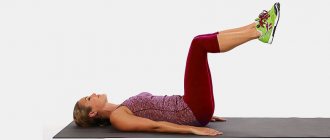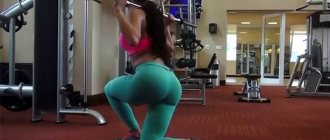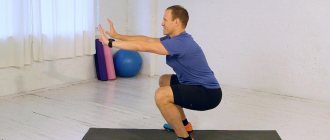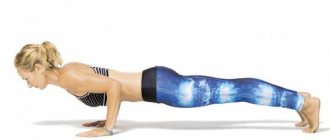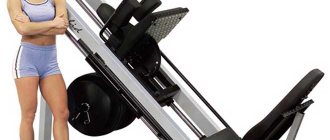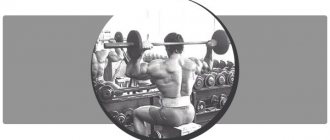Home / Exercises for the buttocks / One-leg glute bridge
Today we will look at a very cool and effective exercise (which I can recommend) for all girls/women - single leg glute bridge. I will reveal all its subtleties, secrets and nuances of implementation.
The gluteal bridge is a lying pelvic lift (different names for the same exercise).
This exercise works great on the buttocks and back of the thighs (hamstrings).
The peculiarity of this exercise is that it is performed lying on the floor, that is, the load on the spine is very negligible, this is not squats and others)) that is, the exercise is very safe and comfortable.
Also, the exercise does not require any additional equipment and can easily be performed at home, even by teenagers.
Electromyostimulation (EMG) indicators (for those who don’t know, this is an indicator of the intensity of muscle contraction, on the basis of which a conclusion is made about which exercise is effective/less effective, etc.):
- on the buttocks - 142.0
- for the biceps of the thighs - 130.0
These EMG indicators relate to work on two legs - on the floor. Not on one leg (no data on one leg).
In any case, the results are very encouraging - these are very decent indicators, to be honest, this EMG exercise showed the highest results for the buttocks, think about how really cool the exercise is!
Even the same squats with a barbell on the shoulders showed the buttocks - 58.0)) draw your own conclusions.
We can say that the lying pelvic lift (glute bridge) is the best exercise for the buttocks. This may shock someone, I understand)) later I will give further explanations on this matter and reveal the disadvantage of this exercise.
The hamstring exercise is also a very cool exercise, the performance is powerful, only the deadlift (Romanian) and deadlift are higher, and so on - well, it’s just a bomb exercise, but unfortunately, it only has 1 minus!!!!
Its only drawback is that it is an isolating exercise (not a basic one).
This means that it should be done only after basic basic (multi-joint) exercises:
- "Barbell Squats"
- "Leg press"
- "Lunges"
- "Deadlift"
This is the only way it will have maximum use (effect), and only this way will you get maximum benefit from it?
In itself - even despite the fact that according to EMG - it has unrealistically cool indicators - it is the best, it will not be able to give you that cool ass that basic strength exercises, such as squats, will give you. Understand?
This is information that has already been proven by many years of experience - well, that’s it, I’m just telling it as it is.
It is isolating - it is not strength - it cannot give the mass, those gains that the same squat will give. However! This exercise simply must be used, but only at the end of the workout - after the basic ones.
No, of course, if the question is whether to do just this or not to do it, it’s better to do at least something than to do nothing at all, but believe me, after the basics this exercise will work a hundred thousand times better, so see for yourself...
What is this?
The glute bridge (pelvic lift) is an exercise designed to train the front and back of the thigh and gluteal muscles. This exercise also helps to stretch the leg muscles and even prevent or at least alleviate lower back pain during menstruation, because improves blood flow in the pelvic area.
Is it possible to exercise during menstruation?
What muscles work
Let's look at what muscles work during the glute bridge exercise:
- large, medium and small gluteals;
- biceps femoris muscle;
- back and front of the thighs;
- calf muscles;
- core muscles;
- spinal extensor muscles.
Also, correct execution of the exercise allows you to work your abs and back - it also helps relieve lower back pain.
Benefit
- the ability to load the buttocks without putting stress on the lower back (unlike squats),
- the gluteal bridge has a simple technique, so usually even beginners do not have any difficulties,
- the abdominal muscles are additionally strengthened,
- and also stretches the back of the thigh,
- variability: you can perform the exercise with your own or free weight even at home, as well as in the simulator,
- improved tone (due to blood circulation) of the pelvic organs and increased libido.
General recommendations
FITNESS. Video tutorial “Gluteal Bridge”.
To achieve balanced development, the glute bridge must be an integral part of the training process. It, like squats, must be done in various variations.
Variety can be achieved by periodically lifting heavy weights or increasing the number of repetitions, as well as using shock absorbers. The variability of the exercise allows you not to get tired of the same monotonous performance of the gluteal bridge, resulting in beautiful and strong buttocks.
Technique for women
The gluteal bridge (bridge, pelvic lift while lying on your back) is an exercise in which it is very difficult to do something wrong, because it is performed naturally and anatomically comfortably.
In a step-by-step version, pelvic lifts are:
- We strongly advise you to perform the exercise on a yoga mat, foam pad, or at least a blanket!
- Starting position : lie on your back, bend your knees, place your heels firmly on the floor. Hands lie along the body or on the stomach.
- As you inhale, tense your buttocks and lift your hips until your body is in a straight line from your shoulders to your knees. At the climax of the movement, hold for 1-2 counts, tighten your buttocks even more and, as you exhale, lower yourself to the starting position. Repeat the specified number of times.
Pay attention to the position of the spine ; you should not bend in the thoracic and lumbar regions. You must also learn to fully raise the pelvis in peak contraction - until a straight line is formed with the torso. If you can't do this, i.e. There is a slight angle in the pelvis, the weight is too heavy for you:
Bridge from a standing position
The ability to stand on the bridge from a standing position looks even more impressive. It will take a little more time to learn how to do a standing bridge, but your diligence will be rewarded by adding this acrobatic element to your arsenal.
To work out a bridge from a vertical post, you will need a free section of the wall. Stand with your back to him at a distance of a couple of steps. Raise your arms up, bend back a little and rest your palms on the wall so that your fingers point down. Move your hands down the wall while arching your back and lowering your head. In this case, you can bend your knees slightly. Reach the highest possible level, and, moving your hands up, return to the starting position.
Perform this exercise for 8 repetitions in two sets each workout, trying to go lower each time. When you can easily reach the floor and climb up the wall from this position, you can try to make a bridge from a standing position without the help of the wall.
Start practicing this stance only when you have learned to confidently do it against the wall. You need to stand up straight, place your feet slightly wider than your shoulders. Raise your bent arms above your head and arch your back while bending your knees and moving your pelvis forward to maintain balance. The gaze is directed back. You need to bend over as much as possible and see where your palms “land.” If the maximum deflection has been reached, but the floor is still far away, then ask someone to secure you by grabbing you around the waist. With your hands on the floor, straighten your legs and arms and maintain your balance. You can stand up from the bridge by raising one arm and turning over to the side.
When you learn to confidently stand up from a vertical position and can easily repeat this exercise without losing your balance, you can move on to the final stage of training, which will help you master the skill of rising from a bridge.
Execution options
Classic without weights
The technique is no different from that described above.
With elastic band
The simplest and most affordable weighting option. We wrote about performing this variation of the gluteal bridge in the article It’s realistic to pump up your buttocks at home: what exercises and equipment are available to you at home?
With pressing, bringing the knees together
This complication of actions will allow you to load your buttocks even more.
How to do it correctly: after you strain your buttocks at the highest point of raising the pelvis, you need to bring your knees together and spread them as many times as possible, as in the abduction-extension simulator . Believe me, your buttocks will simply burn from the pumping !
On one supporting leg
The single-leg glute bridge allows you to better work each leg separately.
- First option. Starting position: lying on your back, one leg bent, the second shin lying on the first knee. As you exhale, raise your pelvis, not forgetting about your straight, tense back, hold for 2-3 counts and, inhaling, return to the starting position.
- Second option. Again, the starting position is lying on your back, one leg bent on the floor, the other straight extended upward. The technique is the same:
On fitball
A fitball (like other unstable support) is a good complication for the gluteal bridge. This way you will have to additionally concentrate on balance and the stabilizing muscles will come into play.
- First way. The shoulders and shoulder blades are on the fitball, the legs are shoulder-width apart, and the feet are pressed to the floor. Exhale with effort and raise the pelvis, pausing for a couple of seconds at the highest point. Slowly return to the starting position.
In this version, the ball acts as a bench. Believe me, it is difficult to stay on such a support, but thanks to this, the stabilizing muscles are included in the work.
- Second way. We place our feet on a fitball and raise our pelvis until a straight line with our torso is formed. Keep your balance! Slowly, rolling the ball back, we return to the starting position.
With weight
With dumbbells
The most obvious and fairly convenient weighting option. What we like about this option is that you can throw the weight on yourself without much difficulty. For example, lifting a barbell on your own is much more difficult!
The technique is not original: we lie down on the mat, bend our knees. We take a dumbbell in our hands and place it on our hips, holding it with our hands.
Raise the pelvis and remain in this position for 2-4 counts, with maximum tension. After this, we lower ourselves without touching the floor with our buttocks! Hold the weight with your hands the entire time you perform it so that the axis of the load does not shift from the buttocks.
You can also perform kettlebell on your butt!
With pancake
The technique for performing a pelvic lift with a weight plate is the same as with dumbbells. You can make it more difficult by doing it from a bench - this allows you to achieve greater amplitude!
Useful training video:
From the bench
There are 2 ways to sit on a bench: you lie down with either your upper or lower body on an elevation - the main thing is to make it comfortable and safe:
What is important to consider:
- It is also important to consider: this option of lifting the pelvis with emphasis on a bench is possible without injury only for flexible people - if you have problems with this, it is better to abstain!
- Ideally, the required bench height is 40 cm . However, you should experiment with different benches to determine your individual, comfortable height, which will help you perform the exercise with maximum involvement of the gluteal muscles.
- The emphasis on the bench should be on the lower edge of the shoulder blades - so that when you lift, you can easily rest your shoulders on it.
- While lifting the barbell, you should not help yourself with your elbows or rest your neck against the support : this can lead to pinching of the muscles and blood vessels.
- If you have one bench in your room, but it doesn’t suit you, you can place a rug folded several times under your butt. If, on the contrary, you are already high, then take a banal step platform.
If you want to further complicate the technique of performing an exercise on a bench, use two elevations of the same height. This will increase the range of motion of your hips to perform a bridge, look at the photo:
You can also add a knee tuck at the peak point or lift one leg up for more work on each of the buttocks. You can also bend one leg at the knee and perform a pelvic lift, first on one leg, then on the other. Of course, these options are for experienced trainees!
In the leg curl machine
Lying pelvic lifts are a more advanced version of the gluteal bridge, which is performed on a lying leg curl machine. Don’t be afraid, this option has a big advantage: you can easily change the working weight and not be afraid of injury, because it is fixed.
You will also have a given trajectory of movement, so it will be easier to perform the exercise.
How to do:
- Lie with your shoulder blades on the edge of the machine bench. Place your legs shoulder-width apart and press your feet to the floor. The roller is located on the line of the hip bone . Hands are on the bolster, and the pelvis is in the canopy.
- Using the force of your buttocks as you exhale, lift your pelvis until it is parallel to your body. Hold for 2 seconds at the top and squeeze your buttocks tightly. Feel the tension in your muscles.
- Lower your pelvis slowly and under control, making sure that the tension does not go away from the muscles! Don’t fall like a fallen willow and don’t sit on the floor at the bottom of the exercise! Repeat as many times as necessary.
Visually:
With a bar and a barbell
Lifting the legs and pelvis with a barbell while lying down is the most inconvenient option, in our opinion. Because you have to independently support the weight of the barbell in the absence of a given amplitude - the possibility of injury is high.
What to pay attention to:
- There is only one correct position of the bar: on the bend of the legs and body .
- As you perform the movement, make sure that the bar does not roll forward or backward across your body.
- It is strictly forbidden to place the barbell on your stomach.
The technique for performing with a barbell is the same as without a barbell.
There are 2 types of bars: Olympic long bar weighing 20 kg and curved short bar from 10 kg. We recommend that you use the second type. But no matter which one you choose, remember that if you feel uncomfortable, painful or uncomfortable, you can put a cushion or towel under it.
People often ask how to lift a barbell? Ideally, the safest and most convenient option is to have someone put it on you, but if a faithful friend is not nearby:
- “Roll up” the barbell over your outstretched legs, if the height of the plates allows you to do this (classic - from 10 kg, crossfitter - from 5 kg),
- place a barbell with a small weight on your hips while sitting on a bench and step down from the bench,
- place a barbell or step platform on both sides - this will create additional space between the bar and the floor,
- overcome your shyness and ask the most handsome guy in the room to help you!
It is most convenient to perform a gluteal bridge with a barbell on a bench:
In the Smith machine
We place a bench next to the machine and lie down on it so that the fulcrum is on the shoulder blades, and the bar is on the line of the hip bone . We recommend that you hold onto the bench with your hands - this will make it easier to make effort when lifting the weight.
Starting position: legs bent and standing shoulder-width apart, toes turned out, pelvis tilted. By tensing the gluteal muscles, we raise the hips to a straight line with the body. At the final point, we linger for a few seconds, squeezing the muscles, then slowly lower ourselves without relaxing.
Do not hold your breath: as you exhale, raise your pelvis, while inhaling, lower it.
The Smith pelvic lift is ideal for those just starting to exercise and those who have poor balance.
Which glute bridge option is best? In fact, each of them is good and effective in its own way: the selection criteria are your comfort, personal preferences and the availability of equipment.
What to replace it with?
Should I replace the pelvic lift exercise with squats and deadlifts ?
Of course not ! And the reason is obvious: these exercises have different loads.
In the bridge, it is aimed at the extensor muscles at the moment of shortening of the gluteus maximus muscles. In squats and deadlifts, the gluteus maximus muscle experiences maximum tension in an elongated state.
Therefore, you can do a bridge with 100 kg. on a barbell, but at the same time squat and deadlift 20 kg. We recommend doing glute bridges once a week, with a medium working weight, up to 10 repetitions for each approach.
How to determine working weight in the gym?
Reviews
Based on feedback from visitors to the hall, we have compiled the main and most important advantages of this exercise:
Marina: I have very big problems with my knees and this is practically the only exercise that the doctor and trainer allow me to do to lift my buttocks!
Bone Wide: yes, the load on the knee joint in the gluteal bridge is not axial and is minimal. So if your knees hurt when squatting, then don’t worry, there will be no pain in this exercise even with weights. The same applies to back problems. There is no axial load on the spine, which means that pelvic lift can be performed for protrusions, hernias and other back problems (but after consulting a doctor).
Olga: I’ve been doing glute bridges for a couple of months now, I’ve eliminated squats and you know, varicose veins have stopped bothering me as much as before.
Broad Bone: Again, we repeat that there is no axial or impact load during this exercise (as when running or jumping) and does not create a lot of tension in the legs (as when doing squats with weights or other movements performed while standing). So varicose veins are not a problem here!
The truthful answer: is it possible to play sports with varicose veins?
Features of the exercise
The glute bridge exercise involves lifting your buttocks off the floor from a lying position. The key word here is not “bridge,” which requires flexibility and plasticity, but “gluteal,” aimed at working the gluteal muscles.
Why "bridge"? Because the exercise is different from the usual raising of the pelvis above the floor. It's all about the shoulder joint. If he is on a hill and the pelvis rises to his level, then this will be a normal buttock lift. In the case when the shoulders lie on the floor when lifting the heel, we will be dealing with a gluteal bridge.
Thanks to the element, we not only improve the shape of the buttocks, but also develop the strength of the gluteal muscles. Having mastered the exercise and brought it to perfection, you can safely move on to more complex and intense elements to work the buttocks, which by that time will already be prepared for increased loads.
The glute bridge is suitable for both beginners and professionals. The variety of options for its implementation allows anyone to master the element. The exercise is accessible even to people with joint problems, the impact on which is minimal. The element is also useful for those who only want to tighten their buttocks, bypassing thigh extensions. The entire load when performing the exercise falls on the buttocks, and does not share it with the quadriceps, as, for example, in squats.

